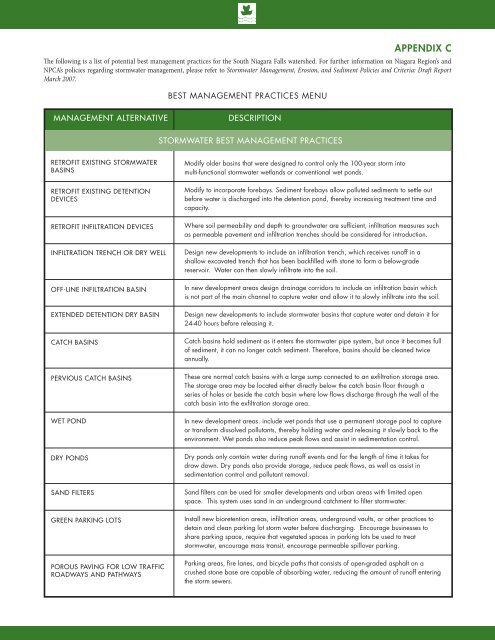8132 - NPCA SNF Watershed Report.indd - Niagara Peninsula ...
8132 - NPCA SNF Watershed Report.indd - Niagara Peninsula ...
8132 - NPCA SNF Watershed Report.indd - Niagara Peninsula ...
You also want an ePaper? Increase the reach of your titles
YUMPU automatically turns print PDFs into web optimized ePapers that Google loves.
BEST MANAGEMENT PRACTICES MENUAPPENDIX CThe following is a list of potential best management practices for the South <strong>Niagara</strong> Falls watershed. For further information on <strong>Niagara</strong> Region’s and<strong>NPCA</strong>’s policies regarding stormwater management, please refer to Stormwater Management, Erosion, and Sediment Policies and Criteria: Draft <strong>Report</strong>March 2007.MANAGEMENT ALTERNATIVEDESCRIPTIONSTORMWATER BEST MANAGEMENT PRACTICESRETROFIT EXISTING STORMWATERBASINSRETROFIT EXISTING DETENTIONDEVICESRETROFIT INFILTRATION DEVICESINFILTRATION TRENCH OR DRY WELLOFF-LINE INFILTRATION BASINEXTENDED DETENTION DRY BASINCATCH BASINSPERVIOUS CATCH BASINSWET PONDDRY PONDSSAND FILTERSGREEN PARKING LOTSPOROUS PAVING FOR LOW TRAFFICROADWAYS AND PATHWAYSModify older basins that were designed to control only the 100-year storm intomulti-functional stormwater wetlands or conventional wet ponds.Modify to incorporate forebays. Sediment forebays allow polluted sediments to settle outbefore water is discharged into the detention pond, thereby increasing treatment time andcapacity.Where soil permeability and depth to groundwater are sufficient, infiltration measures suchas permeable pavement and infiltration trenches should be considered for introduction.Design new developments to include an infiltration trench, which receives runoff in ashallow excavated trench that has been backfilled with stone to form a below-gradereservoir. Water can then slowly infiltrate into the soil.In new development areas design drainage corridors to include an infiltration basin whichis not part of the main channel to capture water and allow it to slowly infiltrate into the soil.Design new developments to include stormwater basins that capture water and detain it for24-40 hours before releasing it.Catch basins hold sediment as it enters the stormwater pipe system, but once it becomes fullof sediment, it can no longer catch sediment. Therefore, basins should be cleaned twiceannually.These are normal catch basins with a large sump connected to an exfiltration storage area.The storage area may be located either directly below the catch basin floor through aseries of holes or beside the catch basin where low flows discharge through the wall of thecatch basin into the exfiltration storage area.In new development areas. include wet ponds that use a permanent storage pool to captureor transform dissolved pollutants, thereby holding water and releasing it slowly back to theenvironment. Wet ponds also reduce peak flows and assist in sedimentation control.Dry ponds only contain water during runoff events and for the length of time it takes fordraw down. Dry ponds also provide storage, reduce peak flows, as well as assist insedimentation control and pollutant removal.Sand filters can be used for smaller developments and urban areas with limited openspace. This system uses sand in an underground catchment to filter stormwater.Install new bioretention areas, infiltration areas, underground vaults, or other practices todetain and clean parking lot storm water before discharging. Encourage businesses toshare parking space, require that vegetated spaces in parking lots be used to treatstormwater, encourage mass transit, encourage permeable spillover parking.Parking areas, fire lanes, and bicycle paths that consists of open-graded asphalt on acrushed stone base are capable of absorbing water, reducing the amount of runoff enteringthe storm sewers.
















